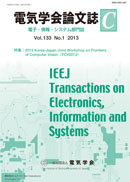Volume 133, Issue 4
Displaying 1-34 of 34 articles from this issue
- |<
- <
- 1
- >
- >|
Special Issue on “Information and System Technologies for Creating a New Service Society”
Special Issue Review
-
2013 Volume 133 Issue 4 Pages 688-692
Published: April 01, 2013
Released on J-STAGE: April 01, 2013
Download PDF (581K) -
2013 Volume 133 Issue 4 Pages 693-698
Published: April 01, 2013
Released on J-STAGE: April 01, 2013
Download PDF (1013K)
Special Issue Paper
<Systems, Instrument, Control>
-
2013 Volume 133 Issue 4 Pages 699-705
Published: April 01, 2013
Released on J-STAGE: April 01, 2013
Download PDF (479K) -
2013 Volume 133 Issue 4 Pages 706-712
Published: April 01, 2013
Released on J-STAGE: April 01, 2013
Download PDF (2502K) -
2013 Volume 133 Issue 4 Pages 713-721
Published: April 01, 2013
Released on J-STAGE: April 01, 2013
Download PDF (4084K)
<Speech and Image Processing, Recognition>
-
2013 Volume 133 Issue 4 Pages 722-729
Published: April 01, 2013
Released on J-STAGE: April 01, 2013
Download PDF (2658K)
<Softcomputing, Learning>
-
2013 Volume 133 Issue 4 Pages 730-739
Published: April 01, 2013
Released on J-STAGE: April 01, 2013
Download PDF (843K)
<Information System, Electronic Commerce>
-
2013 Volume 133 Issue 4 Pages 740-748
Published: April 01, 2013
Released on J-STAGE: April 01, 2013
Download PDF (448K) -
2013 Volume 133 Issue 4 Pages 749-755
Published: April 01, 2013
Released on J-STAGE: April 01, 2013
Download PDF (463K) -
2013 Volume 133 Issue 4 Pages 756-768
Published: April 01, 2013
Released on J-STAGE: April 01, 2013
Download PDF (598K) -
2013 Volume 133 Issue 4 Pages 769-776
Published: April 01, 2013
Released on J-STAGE: April 01, 2013
Download PDF (1491K) -
2013 Volume 133 Issue 4 Pages 777-784
Published: April 01, 2013
Released on J-STAGE: April 01, 2013
Download PDF (1359K) -
2013 Volume 133 Issue 4 Pages 785-793
Published: April 01, 2013
Released on J-STAGE: April 01, 2013
Download PDF (1872K)
<Information Processing, Software>
-
2013 Volume 133 Issue 4 Pages 794-801
Published: April 01, 2013
Released on J-STAGE: April 01, 2013
Download PDF (428K) -
2013 Volume 133 Issue 4 Pages 802-815
Published: April 01, 2013
Released on J-STAGE: April 01, 2013
Download PDF (2306K)
Special Issue Letter
<Media Information, User Interface>
-
2013 Volume 133 Issue 4 Pages 816-817
Published: April 01, 2013
Released on J-STAGE: April 01, 2013
Download PDF (546K)
<Information System, Electronic Commerce>
-
2013 Volume 133 Issue 4 Pages 818-819
Published: April 01, 2013
Released on J-STAGE: April 01, 2013
Download PDF (520K) -
2013 Volume 133 Issue 4 Pages 820-821
Published: April 01, 2013
Released on J-STAGE: April 01, 2013
Download PDF (1777K)
Paper
<Systems, Instrument, Control>
-
2013 Volume 133 Issue 4 Pages 822-830
Published: April 01, 2013
Released on J-STAGE: April 01, 2013
Download PDF (704K) -
2013 Volume 133 Issue 4 Pages 831-836
Published: April 01, 2013
Released on J-STAGE: April 01, 2013
Download PDF (717K) -
2013 Volume 133 Issue 4 Pages 837-842
Published: April 01, 2013
Released on J-STAGE: April 01, 2013
Download PDF (572K) -
2013 Volume 133 Issue 4 Pages 843-848
Published: April 01, 2013
Released on J-STAGE: April 01, 2013
Download PDF (602K)
<Intelligence, Robotics>
-
2013 Volume 133 Issue 4 Pages 849-855
Published: April 01, 2013
Released on J-STAGE: April 01, 2013
Download PDF (1703K) -
2013 Volume 133 Issue 4 Pages 856-863
Published: April 01, 2013
Released on J-STAGE: April 01, 2013
Download PDF (1262K)
<Speech and Image Processing, Recognition>
-
2013 Volume 133 Issue 4 Pages 864-875
Published: April 01, 2013
Released on J-STAGE: April 01, 2013
Download PDF (2648K) -
2013 Volume 133 Issue 4 Pages 876-882
Published: April 01, 2013
Released on J-STAGE: April 01, 2013
Download PDF (2449K)
<Information System, Electronic Commerce>
-
2013 Volume 133 Issue 4 Pages 883-890
Published: April 01, 2013
Released on J-STAGE: April 01, 2013
Download PDF (1441K) -
2013 Volume 133 Issue 4 Pages 891-898
Published: April 01, 2013
Released on J-STAGE: April 01, 2013
Download PDF (1144K) -
2013 Volume 133 Issue 4 Pages 899-905
Published: April 01, 2013
Released on J-STAGE: April 01, 2013
Download PDF (1948K)
Letter
<Media Information, User Interface>
-
2013 Volume 133 Issue 4 Pages 906-907
Published: April 01, 2013
Released on J-STAGE: April 01, 2013
Download PDF (683K)
<Speech and Image Processing, Recognition>
-
2013 Volume 133 Issue 4 Pages 908-909
Published: April 01, 2013
Released on J-STAGE: April 01, 2013
Download PDF (257K)
-
2013 Volume 133 Issue 4 Pages ES4_1-ES4_24
Published: April 01, 2013
Released on J-STAGE: April 01, 2013
Download PDF (2931K)
-
2013 Volume 133 Issue 4 Pages NL4_1-NL4_4
Published: April 01, 2013
Released on J-STAGE: April 01, 2013
Download PDF (321K)
-
2013 Volume 133 Issue 4 Pages L4_1
Published: April 01, 2013
Released on J-STAGE: April 01, 2013
Download PDF (39K)
- |<
- <
- 1
- >
- >|
